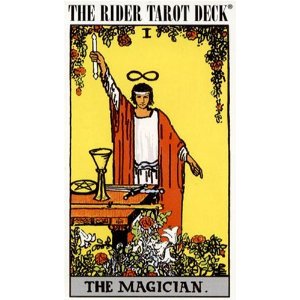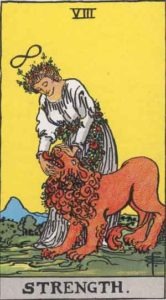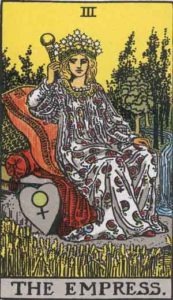 The Rider-Waite Tarot Deck is the most widely used tarot deck today and can be seen as the gold standard of tarot decks.
The Rider-Waite Tarot Deck is the most widely used tarot deck today and can be seen as the gold standard of tarot decks.
This deck was originally published in 1909 by William Rider & Son of London, but is now published by U.S. Games Systems, Inc.This ever-popular deck was a result of the collaboration between artist Pamela Coleman Smith and mystic Arthur Edward Waite.
The Rider-Waite Tarot Deck was groundbreaking for its time because it was the first deck to feature scenes and people on the 56 minor arcana cards. Prior to The Rider-Waite Tarot Deck, the Minor Arcana cards were very simple, illustrated with just the card’s suit and its number, with only the Major Arcana depicting people on them.This deck is also called The Rider-Waite-Smith (RWS) and the Rider Deck.
Likes:
- This deck is the classic, gold standard tarot deck upon which most other tarot decks are based
- Pictures are simple and easy to interpret
- Each card tells a story and evokes a strong feeling
Dislikes:
- Colors can seem a bit garish and the artwork is very basic

The best thing about The Rider-Waite Tarot Deck is how easy the card pictures are to interpret. Even if you know nothing about Tarot, you can look at these cards and get an idea of what they might mean.
Each card tells a story and is full of action and emotion. Getting lost in these cards comes naturally as they invite contemplation and will stimulate your imagination. I find this to be the best deck to use for creative writing exercises. I believe that even someone with severe writer’s block could quite easily write dozens of pages on a single card!
The Rider-Waite Tarot Deck does a wonderful job of capturing the wide variety of human emotions, archetypes and life stages. However, the artwork is more practical than visually appealing. In other words, you wouldn’t exactly hang an enlarged version of a Rider-Waite tarot card in your living room, like you might with other artist’s tarot card renditions.
If prettiness is an important factor for you when choosing a tarot deck, The Rider-Waite Tarot Deck may come up short. The colors are a bit harsh and the drawings are very basic and unimpressive. However, impressing you with it’s beauty isn’t the aim of this deck – providing a solid, no-frills tool for divination is.
This deck’s design was well thought out by mystic and academic Arthur E. Waite and it is full of symbolism and deeper meanings, making it a fascinating deck to study and contemplate. There are many different versions of this classic deck, such as the Radiant Rider-Waite, Universal Waite Tarot Deck and even the Giant Rider-Waite.

Buy this deck if:
- You are a beginner to Tarot
- You don’t have it yet!
The Rider-Waite Tarot Deck (affiliate link) is by far the best deck to learn on and it is a must have deck for every tarot enthusiast and beginner. There are different versions of the classic Rider Waite Tarot Deck, such as the Radiant Rider-Waite, Universal Waite, Giant Rider Waite and others. If you don’t yet have this deck, don’t hesitate to get it – it is the quintessential tarot deck!
Do you have this deck? Share your opinion in the comment box below!
Read more Tarot Deck Reviews…

I originally bought the Steampunk Tarot as my first deck, and although it came with a great book, by Barbara Moore, I quickly realized I needed the RWS deck to really understand the 78 cards. I bought the smaller Centennial RWS deck in a tin first and then the regular size deck. I like the coloring of the smaller deck better—it’s more subdued. I also like the small size for learning, as it takes a smaller area to spread out the cards to study them. The tin keeps them protected in my purse and it doesn’t take up much space. Once I know the cards better I will use the bigger decks to read for others. Thank you Kate for your great instructional videos!
I love mini decks, too, Allyn 🙂 they’re perfect for travel!
This is my second tarot deck used, the first being the Druidcraft deck (Carr-Gohm). In this review, I’ll be making comparisons between the two as these are what I have learned/ am still learning from.
*To Beginners, symbolism is a large facet of reading and understanding, as well as making your own connections between cards in any given spread. You may benefit from taking a bit of time to understand which meanings and representations are commonly associated with popular symbols/ images.
To someone genuinely interested in learning to read tarot cards, this deck is a great place to begin understanding the secrets of the tarot and the symbolism associated with the various suits and numbers. The simplified imagery helps to create focus on the symbolism present in each scene depicted, compared to art styles present on cards in other sets such as the aforementioned Carr-Gohm Druidcraft deck. The elaborate art styles can be pleasing to the eye, but can also be a distraction from the conveyed message. For this reason, I believe the simplicity of the images is excellent for individuals with a genuine curiosity of the art of tarot.
As for convenient understandings of the card meanings this tarot deck had a small booklet included. Carrying on the theme of the cards, simplistic design was implemented to give you the information you need to make your interpretations. Though not quite as well organized and presented as the DC tarot deck booklet, the information you need is present at your fingertips after a bit of navigating. Being a man of considerate proportions, flipping through the tiny pages to locate the meanings associated with each card was a little inconvenient. Aside from the presentation, the information you’re looking for is all present in this book.
The definitions and associations vary between these two decks of cards despite sharing common themes (suits, numbers, major and minor arcana). A personal viewpoint on the obvious differences lay within the art style and the level of personal connection involved. The Rider-Waite deck seems to hold symbolism more directly related to life events and the trials involved whereas the Carr-Gohm deck seems to relate to a more emotionally connected side of self, such as themes of relationships, love, and personal development. This being said the Druidcraft deck was designed with influences of Wicca, Paganism and nature.
I would recommend this deck to people with a genuine interest in learning about the cards as something that is more than a “game” to play with your friends. To the individuals who cast shade on the design of the cards, keep in mind they were originally released in 1909. These are reproductions of originals which is something that is truly only going to be appreciated by individuals who are enthused by these types of things. There are plenty of spin off decks out there based around this collection of art. For this reason, I don’t believe it’s a fair judgment call to say these cards are in any way “bad” based on the simplistic approach to art.
I thoroughly enjoy these cards, even down to the simplicity of the symbolism. Reading and understanding the Tarot is a process involving a flexible mind open to interpretation, meaning it’s not comparable to reading a magazine or cooking instructions for your dinner. For this point, I would strongly recommend this deck to someone looking for a hands on way to learn with minimal visual distractions involved. The cards are roughly 2 3/4″ x 4 3/4″, with the complete deck at about 1 1/4″ so they are relatively small compared to the Druidcraft deck. Ideal for small handed individuals, not so much for the visually impaired. I believe there is a “giant” edition with larger cards and imagery for the large handed and/or poor sighted individuals.
Hopefully this was helpful to any potential plans for those hoping to acquire this deck or get started into doing your own readings/ spreads. I’m also not a fan of the expired mustard yellow that seems to dominate the majority of these cards, however that is something to be taken in stride with the art style and the time period these were originally produced in!
Thanks so much for adding your review here, I enjoyed reading it and I think it will be helpful to others 🙂
I have the original deck but the artwork is too smudgy and not very clear but still a newbie so want to stick with RW. What is the difference between the Universal or Radiant RW deck, which deck is more clearer to see the pics for a newbie? ????
Hi Leanne,
I suggest you go on Google images and search for these decks and compare them. I would say they are equally clear. Radiant rider waite has more glowy colors than the Universal.
Cheers,
Kate
I also used to choose between Radiant and Universal decks. In the first, I like the colors and smoothness of the lines, but on it the faces of people are drawn a little differently from that of Pamela Colman Smith. The second is closer to the original, but not “radiant” enough. I chose Universal deck. She looks adorable, especially in a tin.
I know this is…kind..of plain.its Simple I see they make an universal.gold deck its basically the same just more colorful .I personally like the cats tarot.its hard to distinguish what it means unless Ur an expert..which Im not yet..
I have this one I think its rather plain and ugly…there’s got to be other that are simple and better looking ..I will have to see .
I hate this deck, it is the ugluest deck ever created. I also find it highly misleading that people say this de k is eady to read for a beginner. It is hard to read a deck of cards if you are revulsed by them.
I dislike this deck too but ist good for a study deck and because most decks are based on the Rwand Tarot books refer to this deck always. also it is still a classic but for me the Morgan Geer Tarot is better
I have the Rider Waite cards, and pictures and coloured combinations is good , I tried to learn from my teacher , still amateur.
love the rider waite and I think the symbolism on the cards is fantastic and very true to form for the querent – they are also great for quick yes/no answers.